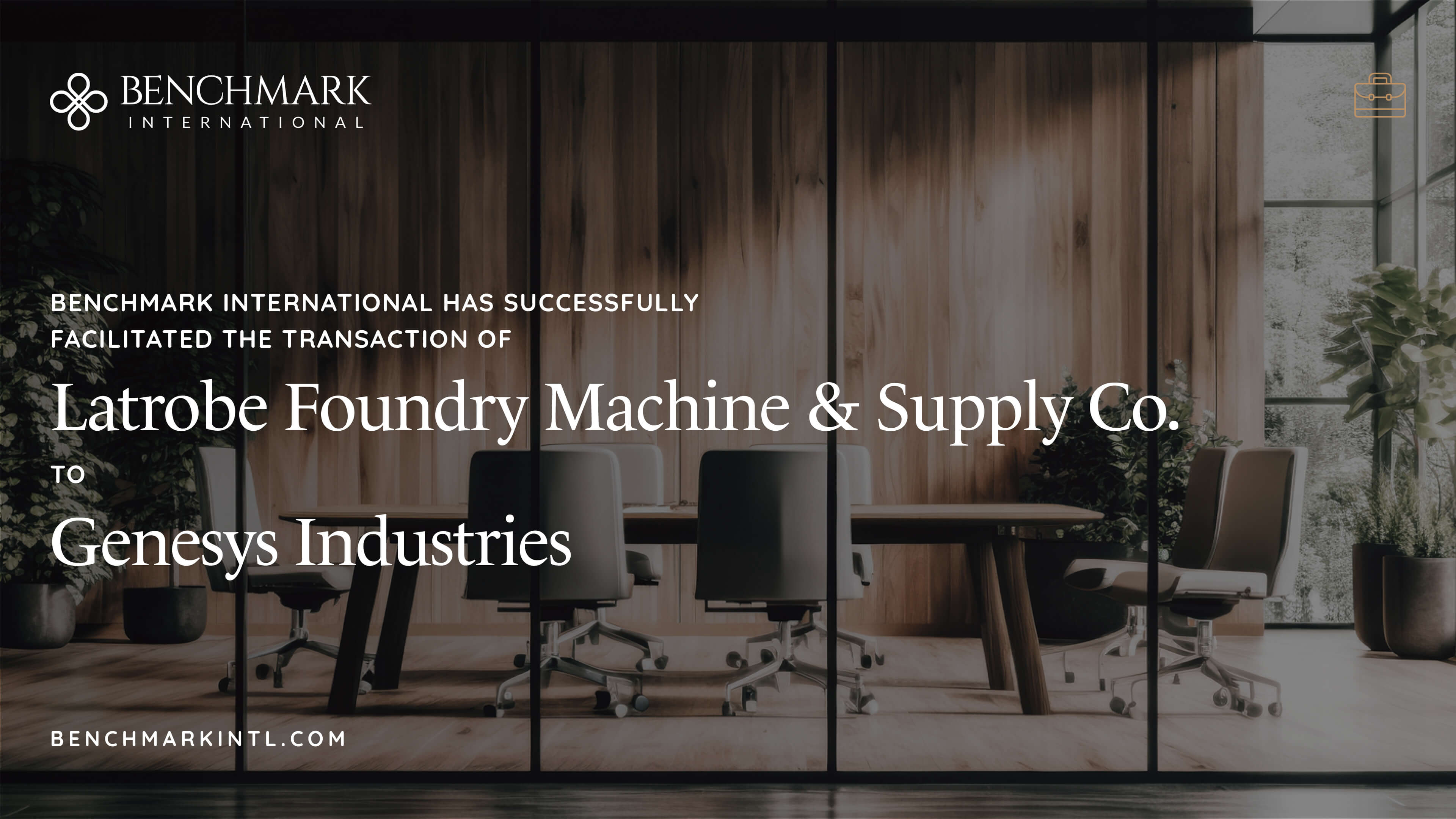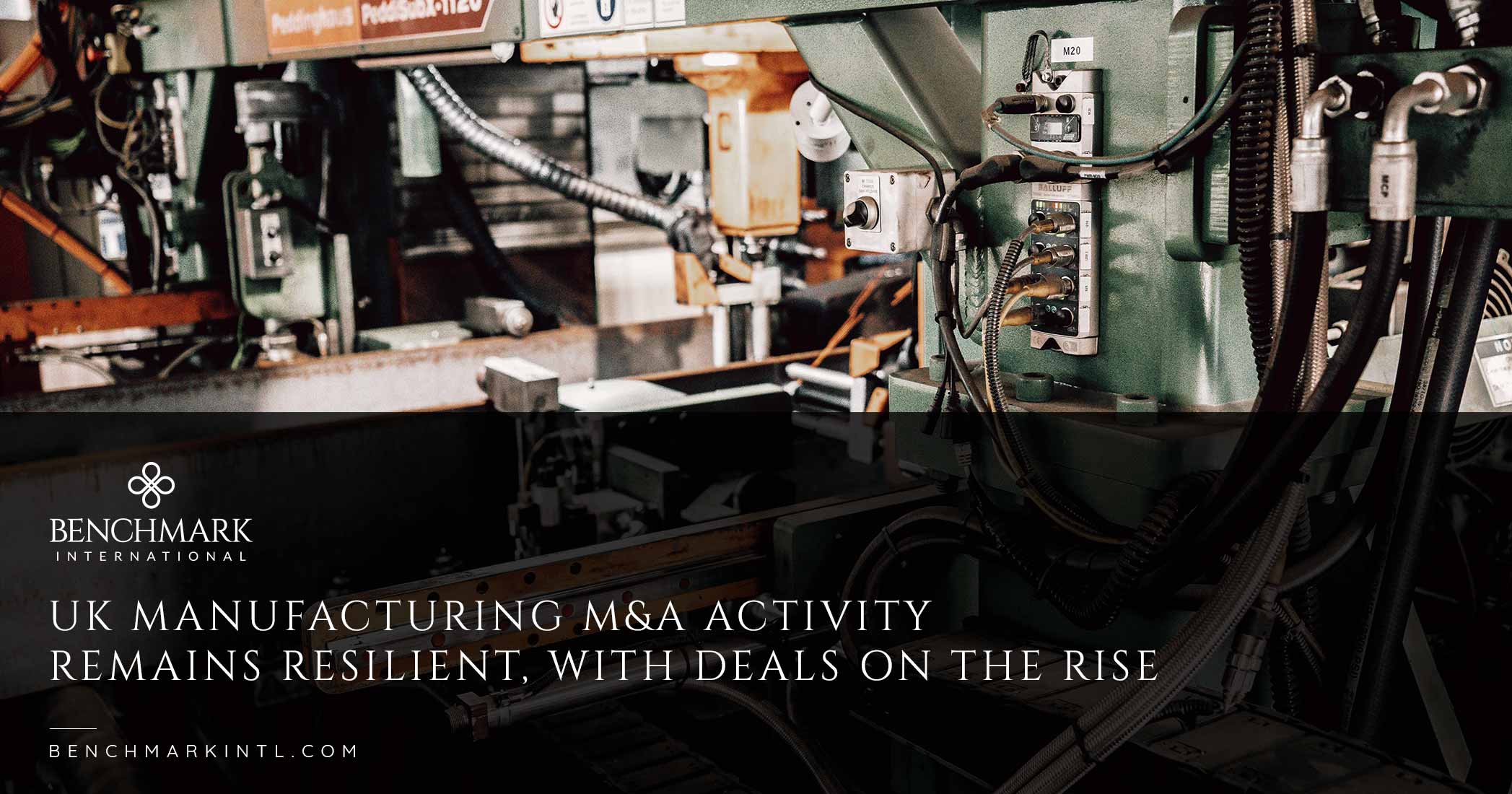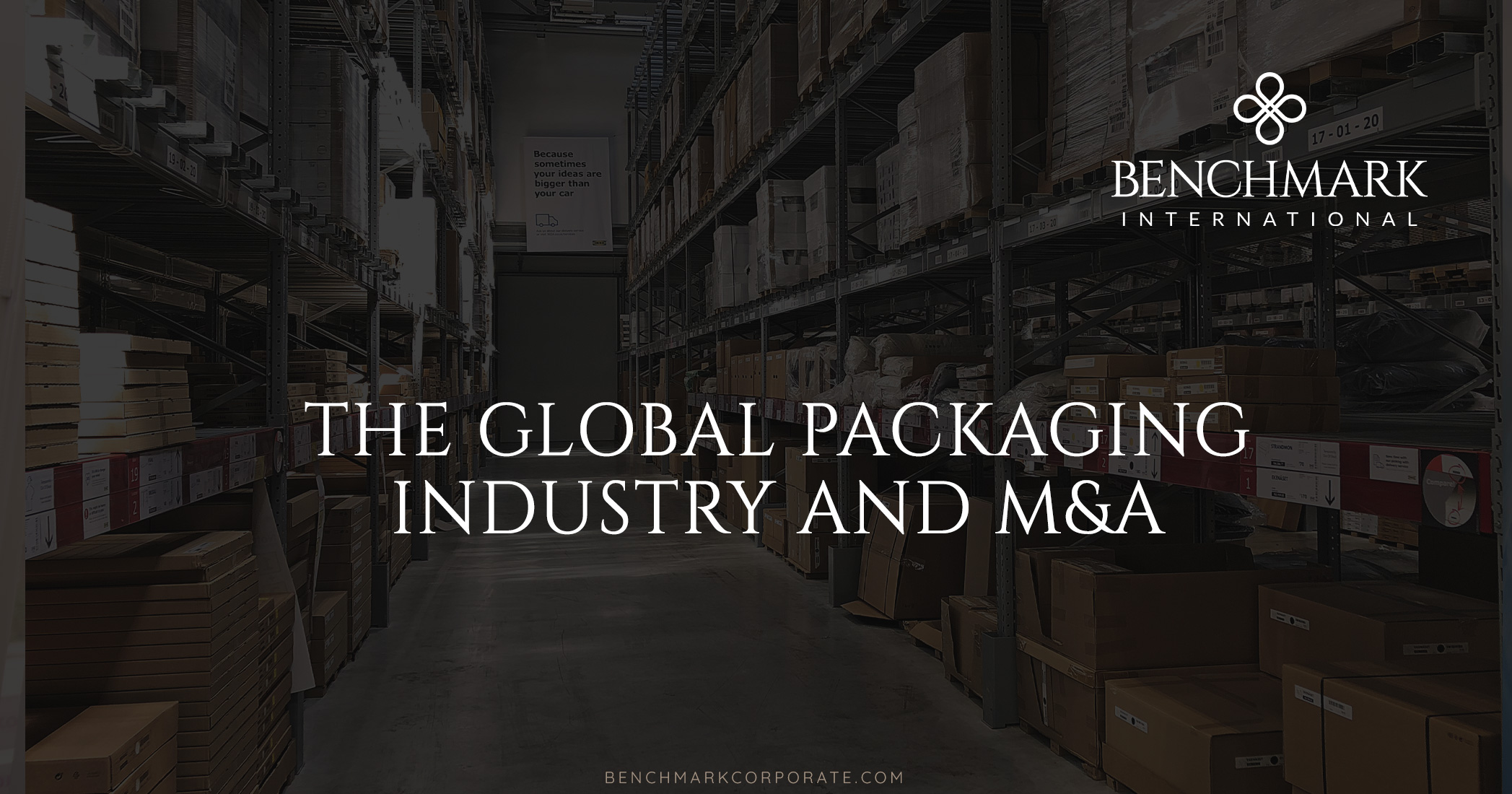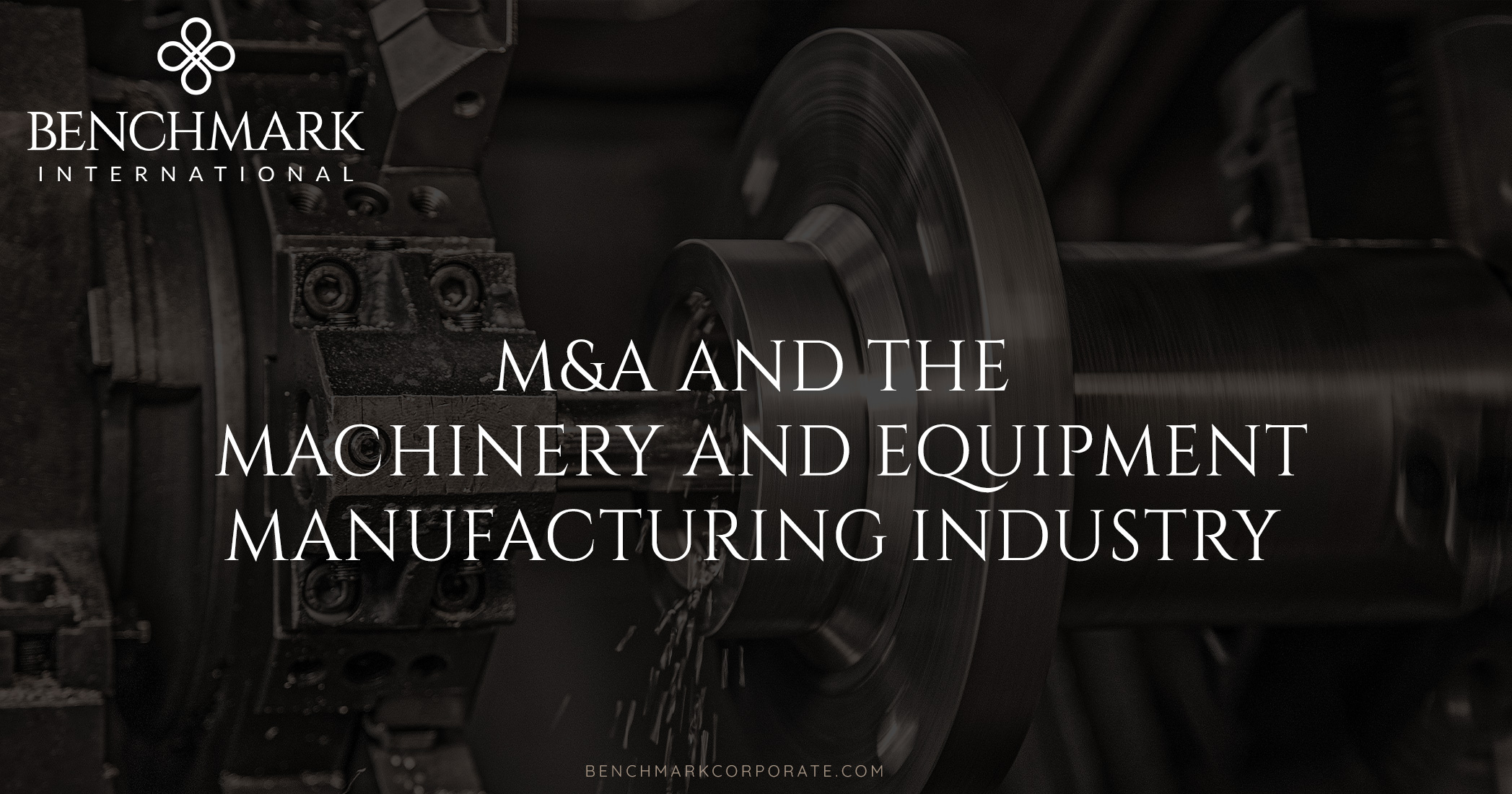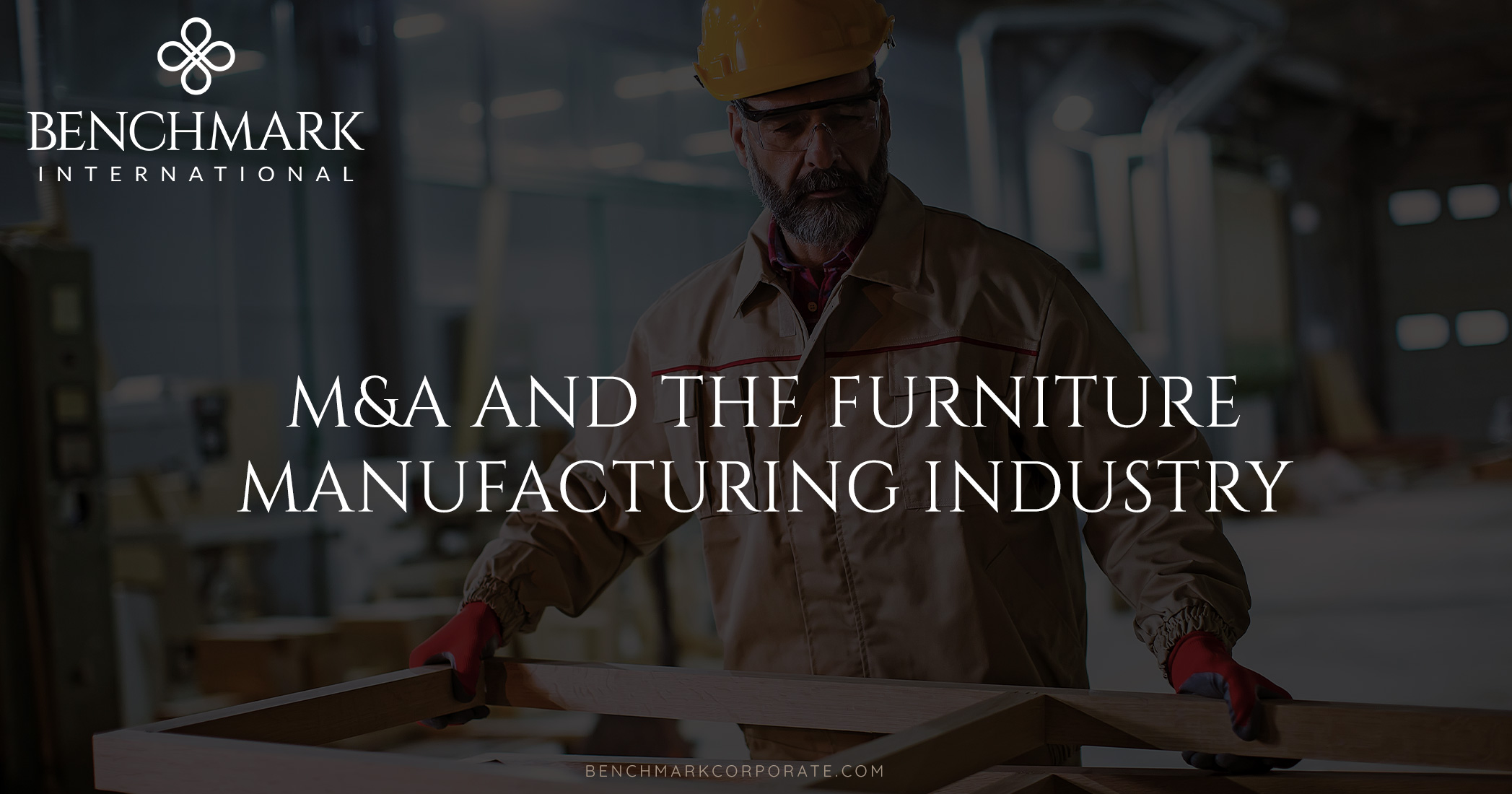Latrobe Foundry Machine & Supply Co. was founded in 1933 by Louis C. Steiner and is a leading manufacturer of high-quality threaded and flanged aluminum pipe fittings and hardware. Latrobe Foundry Machine & Supply Co. is a multi-location manufacturer with an established product line in various businesses, including aerospace, agricultural, chemical, construction, and marine industries.
READ MORE >>Archives
Benchmark International Has Successfully Facilitated The Transaction Of Latrobe Foundry Machine & Supply Co. To Genesys Industries
UK Manufacturing M&A Activity Remains Resilient, with Deals on the Rise
The UK manufacturing industry remained resilient in 2022, with 2023 also off to a promising start.
A challenging economic environment has cast uncertainty on the sector, but in a report by Irwin Mitchell that examined deal information from Experian’s Market IQ database, it revealed that 1,344 UK manufacturing businesses were the target of M&A activity in 2022, in comparison to 1,285 in 2021 and 1,231 in 2020, its highest level since 2016.
The UK manufacturing sector has also seen a continued interest from overseas investors, with 30% of deals coming from abroad. The US was the largest investor, accounting for 8% of deals, followed by Sweden, Germany and France.
READ MORE >>Share this:
2020 Industrials Sector Update
The industrials sector has had to adapt to significant disruption due to the global COVID-19 pandemic, and the challenges associated with it. While 2020 started on a very positive note with rapid growth for the global manufacturing sector, manufacturing output plummeted throughout the beginning of the year and into May due to shutdowns around the world. Output, new orders, exports, and purchases all fell to levels not seen since the 2008 recession. Many large manufacturing countries were under lockdowns into April, but restrictions were eased in May, which helped deter the overall rate of decline. In the wake of the crisis, many companies have found ways to evolve and use digital solutions to transform their business models, discovering changes that will continue to be beneficial in a post-COVID world. This adaptability is crucial to the survival and future relevance of these businesses.
Industry Highlights
- Automation and connective worker technologies have become even more important to boosting productivity.
- Migration to the cloud allows companies to be more flexible in dealing with disruptions.
- The auto manufacturing industry is growing more resilient due to greater supply chain visibility.
- For oil and gas companies, advanced digital technologies are a vital investment.
The Fourth Industrial Revolution
Industrial companies that made prior investments in digital technologies and IT infrastructure were able to operate efficiently during the earliest phases of the pandemic. The Fourth Industrial Revolution, also known as Industry 4.0, has enabled manufacturers to evolve their traditional supply chains and processes into highly interconnected systems. Leading organizations have been investing heavily in developed digital platforms specific to the industrials sector, pivoting business models towards being more software-centric. Additionally, smart manufacturing technologies are now transforming traditional manufacturing processes and paving the way into the future. More and more companies will be exploring digital technologies to enhance their flexibility and operate more innovatively. Robotics and 3D printing are among the most popular operational solutions that are expected to see continued heavy investment.
While remote work has become a relatively easy and normal option for many employees across different sectors, the industrial manufacturing sector is not one of them simply for logistics reasons. For example, machines need operators to keep them running. However, it has been demonstrated that technology can help limit the number of people needed to maintain operations.
Connected worker technologies are helping to streamline and hasten solutions. Typically, machine repairs require operators to contact service technicians, sometimes located in different facilities or at the original equipment manufacturer. Also, training new or existing workers has typically been face to face. Augmented reality is helping to eliminate in-person interaction for the purposed of repair, service and training and empowering workers to be more independent through digital on-demand access to manuals, instructions, and other resources.
While manufacturing companies tend to be more hesitant about migrating operations to the cloud, these organizations are realizing that cloud technologies enables them to move inventory, work smarter, customize products, and shift resources in much more flexible manner. The cloud is also an effective asset-performance tool that gives supervisors a remote window into facilities, production lines, and individuals.
Robotics and automation have significantly increased productivity for manufacturing processes. By replacing manual processes with automated alternatives, it helps to mitigate workforce availability challenges and reduces the impact of low-cost labor decisions.
Additive manufacturing and 3D printing continues to evolve and has shifted from the production of prototype applications to finished products. These manufacturing technologies are gaining more traction and offer efficient value chain solutions that enable on-demand production, less working capital, reduced supply chain complexity, fewer tools or parts needed, and less frequent human intervention.
The Auto Industry
Technology and connectivity is now the third most cited investment priority for the
automotive manufacturing industry. The future lies in edge computing, monitoring software, and the Industrial Internet of Things. Companies are able to collect and analyze data on site and in real time, connect applications to essential equipment, and conduct advanced monitoring and remote controls.
Another result of the pandemic for the auto industry is a need for more transparency in global supply chains. Thanks to AI, there is a shift from existing models in equipping automakers so that suppliers can use analytics to respond to changes in real time. For middle-market companies that have been known to underinvest in tech, this shift is especially important. Investment in IT infrastructure will help establish a more nimble and scalable environment, and will create more valuable data. The sequentially distributed databases of Blockchain technology are also changing supply chain management and adoption is expected to increase greatly into the future.
The Oil and Gas Sector
Digital technologies are also being adopted by oil and gas companies in order to bolster cost and operational efficiencies, improve safety, and reduce environmental impacts.
Robotics, AI, cloud solutions and Blockchain are all being used more and more to advance the industry. According to Bloomberg, oil companies are expected to spend $1.3 billion on advanced analytics alone in 2021. The big oil and field services companies with more experience aggressively adopting innovation and that are in favorable cash positions are more likely to continue investing in new tech. Human intervention is being scaled back. Maintenance procedures are being automated. Drones are being used to monitor real-time conditions and detect leaks. AI sensors are monitoring conditions such as temperature and vibration. At the same time, small and mid-size companies that were less mature coming into the pandemic are likely to focus spending on technology that helps them keep their businesses running.
Contact Us
No matter what sector your business operates within, Benchmark International is here to help. Contact us to discuss how we can help you grow or sell your business for maximum value.
READ MORE >>Share this:
M&A And The Chemical And Plastics Manufacturing Industry
The chemical manufacturing industry converts raw materials such as gasses and oils into chemicals such as ethylene, propylene, methanol, benzene, chlorine, and paraxylene. These chemicals are feedstocks for value chains that produce a wide array of intermediates, plastics, and performance materials that are used to create more than 70,000 registered productsaround the world. It is an extremely diverse and complicated industry. Because many of the industry’s products are intermediates, the customers of chemical companies are often other chemical companies.
M&A Strategies
Among the many factors that influence multi-billion dollar investment decisions include energy market trends, global economic growth, and regional trade dynamics. Investors seek sustainable competitive advantages regarding the costs of energy and feedstock, technology and scale, proximity to markets, and degree of integration.
Mergers and acquisitions have been a long-time tactic used among chemical companies to create growth, change strategic course, and consolidate segments. In an industry that has seen major expansion, certain factors can complicate M&A. This includes the substantial size of some transactions and merger-of-equals deals that are more complex to carry out.
Key drivers of M&A in the chemical manufacturing industry include:
- The pace of organic sales growthin sub-segments
- Consolidation driven by a need for innovation and fewer opportunities to differentiate from competitors in high-value and specialty-chemical areas
- The state of capital-markets returns and a campaign for higher valuations
- An abundance of capital and private equity interest and access to low-cost finance
Digitization & Optimization
Technology continues to transform all industries in the modern world, and the chemical manufacturing industry is no different. Data management through advanced analytics is enabling plant optimization across sites, improved supply chains, and infrastructure synergies. Digital solutions reduce downtime and costs as a result of maintenance and repairs. Sensors monitor plant and warehousing conditions, improving logistics. Also, a vast amount of field operator workload can be transferred to automation and robotics, allocating people resources elsewhere in the business and creating more opportunities for up-skilling. Implementation of these technologies results in revenue improvements.
The Circular Economy of Plastic Waste Recycling
Plastics production accounts for more than one third of the chemical industry’s manufacturing activities. But only a small percentage of these plastics are being recycled, resulting in resources that are lost forever into landfills. Global plastics waste volumes are expected to reach 460 million tons per year by 2030. Public outcry for sustainability is rising and raw material supplies are growing tighter, forcing the chemical industry to adapt on this issue. New plastic recycling methods offer new opportunities for value-creating growth for petrochemicals companies. Instead of focusing on the problem that plastic waste creates, companies are starting to recognize the billion-dollar profit pool it represents through new types of businesses, resulting in an entirely new landscape for M&A activity.
Activist Investors
Additionally, activist investors are playing a larger part in the chemicals sector. Activist investors attempt to create change within a company by purchasing a large number of shares or board seats. These players are emerging influencers of M&A activity and they have an ever-increasing role in the chemical industry through restructuring initiatives. This creates new challenges for industry executives because long-term strategic planning is not a typical priority of activist investors. Although activist investors are capable of delivering solutions that add value, they usually are more interested in shorter-term, higher valuations and results. This often results in cost-cutting measures, shareholder buybacks, and the splitting off of company divisions.
Successful Chemical Industry M&A
Deals that employ proven M&A best practices will yield higher total returns to shareholders. Capturing the full value potential of a deal requires specific industry knowledge and expertise. To craft a successful deal in the chemical sector, sellers should enlist the advice and methodologies of dedicated M&A experts such as those at Benchmark International. They should also:
- Monitor the field to identify potential opportunities
- Review their portfolios to ensure current assets fit their core business
- Look for gaps that may need to be filled for fast action when opportunities arise
- Prepare non-core businesses in order to maximize value from a deal
Contact Us
Are you thinking about selling your business? Set up a time to quickly chat with one of our global M&A specialists to discuss your options and opportunities. Our expertise spans several industries and continents and our talented people are dedicated to achieving your personal objectives.
READ MORE >>Share this:
The Global Packaging Industry and M&A
Manufacturers in the global packaging industry produce items such as bags, films, air pillows, bubble cushioning, heavy plastics, aluminum foil, paperboard, and corrugated materials.
In a segment that is greatly influenced by transportation and logistics costs, strategic buyers look for options that offer attractive margin profiles, cost-savings manufacturing advantages, shareholder growth options, and deals that broaden industry presence and consolidate business lines. Private equity buyers are inclined to focus on niche opportunities that leverage unique and proprietary capabilities and offer strong returns.
In this particular sector, lenders tend to show willingness to finance deals among packaging companies, which boosts healthy valuations. This is because packaging manufacturers are able to generate strong cash flow and are not overly vulnerable to economic downturns.
Growth from E-commerce
As long as e-commerce continues to thrive and the world demands sustainable and cost-efficient packaging solutions, the demand for packaging products will persist, driving mergers and acquisitions activity in this highly fragmented industry.
Protective packaging solutions are naturally of significant interest to e-commerce companies, as is machinery that uses automation to improve packaging processes. There is a demand for packaging companies that can offer innovative and attractive packing solutions that are protective but lightweight and focused on reducing package footprint size.
Fast-Moving Consumer Goods (FMCG)
The FMCG segment involves high-volume, low-cost products that move quickly off the shelves of stores, such as paper products, cosmetics, medicines, detergents, and plastic goods. Packaging is top priority in the FMCG market because of how it directly affects brand positioning, differentiation, and high visibility through the use of graphics and product information. It plays a major role in consumers’ purchase decisions in a very competitive environment.
FMCG packaging makes up a large share of the costs involved in product manufacturing. Companies must look to innovation in packaging to reduce operational costs.
Increasing populations, technological advancements, and a demand for eco-friendly packaging are all key drivers of growth in the FMCG sector. Food and beverage is the largest market for investment from packaging companies.
On the supply side, the FMCG packaging market is highly fragmented with fewer companies having a substantial share in the overall market, leading to fewer barriers to entry. Additionally, the challenges for growth in this sector include issues surrounding skilled labor, equipment and machinery.
Healthcare and Pharmaceuticals
Medical plastics are a major driver of high valuations in the packaging sector. The healthcare industry is subject to significant regulatory and technical requirements and there is a need for companies that can fulfill their specific and complex packaging needs, which include thermoforming and injection molding techniques. The injection-molding sector is especially fragmented and highly competitive with steadily growing revenues and opportunities for consolidation.
There is also a demand for smart packaging technologies that help to combat the counterfeiting of medicines.
Packaging companies that serve medical device and component companies tend to enjoy stronger customer relationships, steadier revenue, better pricing power, and higher valuations. M&A activity in this area is highly focused on technology and expansion of capabilities.
Sustainable Solutions
Sustainability is an important factor in the packaging industry at every step of the value chain, as consumers and regulators apply pressure regarding environmental impacts of packaging applications. In addition to functionality and convenience, it is a key criterion in purchasing decisions. This demand for novel solutions and green technologies creates a noteworthy opportunity for industry players.
Plastics are cost-efficient, convenient, and have useful characteristics in packaging, so their use remains in demand. However, there is a sweeping campaign to reduce the use of plastic in packaging materials.
Airless packaging systems are a growing market. They are designed to limit waste and contamination while improving product shelf life. These packaging products include bags, pouches, bottles, jars, and tubes.
As there is a growing need for packaging companies to lessen the environmental effects of their products, those that stay ahead of the curve by incorporating these solutions will benefit from substantial growth opportunities and will draw plenty of attention for M&A activity.
Contact Us
If you feel the time has come to enter into a merger or acquisition, reach out to our specialists at Benchmark International to get the ball rolling. Our customized solutions, global buyer network, and proprietary methodologies have the power to execute deals that are designed to always exceed seller expectations.
READ MORE >>Share this:
M&A And The Machinery And Equipment Manufacturing Industry
The modern manufacturing industry on a whole is continually undergoing somewhat of a seismic shift in operations thanks to rapidly changing technologies, globalization, rising wages, and demands for higher quality standards, shorter timelines, and more customization. These factors reshape strategic imperatives and decision making, largely in part to emerging disruptive technologies in the machinery and equipment manufacturing industries.
Technology Driving M&A
As is the case with most industries in the 21stcentury, the availability of new technologies is driving major opportunities for mergers and acquisitions in the industrial-equipment manufacturing sector. Some of these game-changing technologies include:
- Data Centers: As the use of data centers becomes more and more prevalent in the machinery and equipment manufacturing industry, there is an increasing demand for mass power generation and back-up power generating systems. Because data centers consume a tremendous amount of energy, there is also a need for growth within the market of energy-efficient industrial solutions that have the capability to reduce operational costs. The data center construction market is forecasted to reach $45 billion by 2023.
- Sensors and Control Systems: Wireless sensor networks offer a cost-effective way for data center operators to implement system changes that reduce energy consumption. Sensors detect and log specific operating conditions such as temperature, pressure, torque, load, and lighting. Control systems ensure proper workflow and identify potential problems and hazards. The addition of these technologies expedites digital strategies and creates a solid platform for connected solutions in safety and maintenance. By the year 2022, the sensor market is expected reach $27.4 billion and the control systems market is projected to reach $50 billion.
- High-performance Computing (HPC): HPC is the practice of aggregating computing power in a manner that enables performance that is far beyond what is capable of typical desktop computers. It uses parallel processing to run advanced applications quickly and efficiently. Companies in the equipment-manufacturing sector are using HPC throughout the entire product lifecycle.
- Automation: Industrial companies are increasingly using automation and predictive analytics to overhaul processes, improve capabilities and rectify previous operational inefficiencies. Specifically, automation is playing a major role in the use of industrial machinery in the food and beverage sector, driving M&A transactions. The global factory automation market is expected to reach $368.4 million by 2025.
- The Internet of Things (IoT): The implementation of all of these technological advancements has led to a need for IoT networks that connect them across operational platforms. These networks enable machinery and equipment to communicate for the purpose of recording data, merging systems, and rooting out costly disruptions. The access to such knowledge gives companies the power to improve their manufacturing processes and the entire supply chain. The global industrial IoT market is expected to reach $933.6 billion by 2025.
Driving Acquisitions and Competition
Because it is simply easier for large industrial companies to buy smaller niche companies that offer specialized technological capabilities rather than attempting to develop them in-house, acquisitions in this sector are a favorable tactic. Additionally, the ability of a buyer to leverage new technology within its own operations and distribution channels gives strategic acquirers far better synergistic potential. Even in light of this fact, there remains growing interest on behalf on private equity investors, creating a competitive M&A environment in the machinery and equipment industry.
Target Company Attributes
Regarding M&A activity in the global machinery and equipment manufacturing industry, target companies that possess the following characteristics typically garner higher multiples:
- Predictable revenue stream
- Stable contracts with well-capitalized customers
- Long-term customer relationships
- Demonstrated sales diversification strategies
- Business lines that can withstand cycles and recessions
- Opportunities for growth
- New end-markets and geographical locations
- Cross-selling to existing customers
- Bolt-on acquisitions
- Growth-supporting infrastructure
- Ability to maintain projected revenues
- Long-term control over facilities
- Proper maintenance of equipment
- Technical product differentiation
- Strong and stable management
- Depth and continuity
- Cohesive culture
- Technology investments
- Strong finance management
- Post-enterprise resource implementation
- Dependable, quality data
It is strongly advised that business owners who are seeking M&A strategies partner with an experienced M&A advisory firm that understands the intricacies of the industry and has the kind of global connections and prowess that maximizes value.
Contact Us
Is it time to make a move? Our experts at Benchmark International are standing by, eager to partner with you on M&A strategies that can achieve all of your objectives for the sale or growth of your business. Please contact us at your convenience.
READ MORE >>Share this:
M&A And The Electronics Manufacturing Industry
The electronics industry manufactures electronic equipment used within industrial electronics such as semiconductors, as well as consumer electronics such as televisions and smartphones.Companies in this sector design, develop, manufacture, assemble, and service equipment and components.
By the year 2024, the global consumer electronics market is expected to reach
$1.78 trillion.
Growth within the electronics manufacturing industry is driven by the following factors:
- The demand from emerging market economies
- Investment in foreign production of electronics, which results in new factories and factory expansions
- Increased consumer spending
- Increased competition that drives down production costs and expands the availability of affordable electronics products
- Development of new technologies
The Semiconductor Segment
The semiconductor industry creates products such as memory chips, microprocessors, integrated circuits, and specialized processorsfor a wide variety of uses in electronics and computers. Primarily, large companies dominate this particular industry segment, but smaller, niche players are carving their place in the market.
The semiconductor industry is highly influenced by new technologies and global economic cycles. When product prices are high, companies produce more of them. This saturates the market and prices drop. As a result, some companies choose to produce less, gradually driving prices back up. The industry also requires a great deal of capital, and research and development, and is subject to long lead times from concept to production.
Because there is much reliance on economic environments—plus there is the high degree of risk due to cost of R&D—smaller companies and startups tend to prefer to be acquired by a larger semiconductor company as a more realistic strategy to create steady future growth.
Next Wave Tech
Over the next couple of decades, printed, flexible and stretchable electronics will continue to represent a massive opportunity in the future of tech, as well as M&A activity. These electronic innovations include:
- E-textiles, smart clothing, and wearable electronics
- Flexible displays and screens
- High-performance, low-power electronics
- Wearable and mobile health monitoring tools
- Flexible, foldable, roll-able batteries and photovoltaic technologies
- Miniaturized components
Automotive Electronics Evolution
As software and electronics play an increasingly essential role in vehicles, the communication technology giants have been aggressively investing in the automotive industry. At the same time, traditional auto manufacturers are actively seeking to partner with technology companies in order to be more productive at digitizing and innovating their offerings. These market dynamics and adaptive strategies are key drivers of M&A in the automotive electronics sector.
The market for automotive electronics is expected to exceed $100 billion by 2025.
Restructuring through M&A enables these companies to better integrate, reconfigure, and pool resources, gain new and specific knowledge, and enhance overall capabilities.
Integration of cultures can be an important challenge when a smaller tech firm converges with a giant conventional automaker. For M&A to be successful, both companies in the transaction must be mindful of how greatly differing cultures need to be integrated with care.
Achieving Successful M&A
Beyond cultural integration, other important considerations in an M&A transaction between organizations include:
- Proper targeting and vetting of both companies
- Identification and mapping of internal processes of both organizations
- Evaluation of the structural fit for each organization
- Locations of all global and regional offices and facilities
- Synchronization of the data, applications, and types of technologies used by each organization
- Assessment of how their legacy systems and languages might conflict or be enhanced
It is also critical to the deal that both parties are kept on track and expectations are properly managed. This is where the partnership with an M&A advisory firm can make all the difference in a smooth transition and the ultimate success of the deal. This valuable partnership can also save significant time and financial resources.
Contact Us
If you wish to formulate a plan to sell, grow or exit your company, contact us at Benchmark International today. Our experts are uniquely qualified to coordinate deals that deliver on every single wish and stipulation expressed by the business owners with which we form long-lasting partnerships.
READ MORE >>Share this:
M&A And The Textile And Apparel Manufacturing Industry
The Course of the Apparel Industry
Several factors have reshaped, and continue to reshape, the worldwide textile and apparel manufacturing industry. The paradigm has shifted into a digital market that demands speed and agility from industry players. These sweeping influences create drivers of increased mergers and acquisitions activity in this market.
- Online expansion, the reduction in brick-and-mortar store locations, and omni-channel shopping
- Sophisticated tech-savvy consumers and social media influencers
- Digitization of payments, points of sale, logistics and delivery
- Demand for fashion at lower prices
- A growing market for fair fashion and demand for increased sustainability as younger generations call for reduced impacts on the environment
- Cost-cutting measures and restructuring to focus on core brands
- Emerging markets of second and third-tier cities and the assertive expansion of fast-fashion retailers
The E-commerce Race
Becoming a go-to platform for customers in the apparel industry means that companies are forced to innovate and diversify their offerings to provide added value, relying less on retail margins. This not-easy task can be accomplished through internal research and development, or mergers and acquisitions.
Changes in Fashion Ownership
Consumers are becoming more interested in different ways to extend the lifespan of fashion items as new companies crop up that offer used clothing, refurbished apparel, and even clothing rental. As more of these new companies emerge, the existing fashion retailers must to adapt to embrace these new ownership models, which are being heavily driven by younger generations that still want new clothes but are more concerned with sustainability. Even luxury brands are embracing this model, but are buying resale or rental businesses so that they can maintain control over the marketing of their brands.
Thinking Small
More and more consumers—and investors—are being enchanted by small brands with interesting and genuine stories. Younger generations prefer small brands and authenticity. Digital marketing changes how the brand narratives are conveyed and provides a cost-effective vehicle to reach larger audiences. And retailers want the differentiation that draws customers in and boosts their margins. Small brands are also able to cater to niche shoppers and more nimbly react to market trends. These small apparel companies are seeing billions of dollars in funding. The giant fashion brands must adapt to this shift in philosophy and add small brands to their portfolios.
On-Demand Fashion
Data analytics and automation have created a new market for companies that focus on made-to-order manufacturing of apparel. Small-batch production cycles are a result of the need for a more rapid response to changing trends and consumer demands, as well as a reduction in overstock.
From a financial viewpoint, on-demand fashion production has both benefits and drawbacks. It requires lower capital investment. It leads to smaller inventories, which means more agility. And faster turnaround cycles can ease demand uncertainties and make production more sustainable. In contrast, production and transport costs are typically higher because of the smaller batches.
Digital Textile Printing
Conventional textile printing methods (rotary screen or flatbed) are being abandoned for newer digital printing methods, especially in European countries. Digital printing allows textile manufacturers to respond to an increasing demand for fast fashion through shorter production runs and customization.
This tech-driven printing sector is drawing the attention of private equity and strategic investors. M&A deals in this space create companies that combine specialty technical mastery with the market and monetary reach of large corporations.
M&A Motivation
There are several reasons to sell a company in this sector. It can be too expensive to keep up with new trends in such a quickly changing operating environment. It can be beneficial to sell within a segment that has high valuation levels (such as affordable luxury or athletic wear). Additionally, brick-and-mortar retailers can sell assets to focus on the development of their flagship and online stores.
There are also many reasons to buy a company in this sector, such as the integration of the supply chain from manufacturers to wholesalers. It can also drive geographical expansion or growth into a new segment, especially emerging markets with developing economies. Another tactic can be to leverage existing brand equity to profit from a known brand that the current owner cannot afford to maintain or grow. Plus, the ever-changing technology landscape means new opportunities within tech companies that serve the industry.
Contact Us
Let’s talk about a plan to sell your business. Contact the experts at Benchmark International to start strategizing for a sale, growth, or your exit from the company. We are eager to get to work with you.
READ MORE >>Share this:
M&A And The Furniture Manufacturing Industry
The furniture manufacturing industry includes the design, production, distribution and sale of household, institutional and office furniture and related products. Global furniture sales are expected to increase 5% each year through 2025. According to Dun & Bradstreet, the countries that are home to the most furniture manufacturing companies are Brazil (72,063), China (62,832, Poland (22,389), with these three accounting for more than half of the world’s furniture manufacturers (54.9%).
Mergers and acquisitions deals in the furniture manufacturing industry are driven by a variety of factors:
- Healthy economies and housing trends
- Major retailers looking to tap new markets
- Vendors seeking category and price-point expansion
- Foreign manufacturers looking to grow geographical production
- Increased investor confidence due to Millennials approaching their prime spending years
- Family-owned businesses with aging management and no succession plan
Consolidation Within the Industry
Furniture needs are evolving and the industry is seeing overlap between residential, hospitality and commercial projects, creating increased appetite for acquisitions.
Strong, existing industry players are known to utilize M&A to expand their global footprints, product lines and price-point offerings. Building out helps companies to gain market strength and enhance shareholder value.
In some regions, labor shortage issues present a challenge. Therefore, companies with trained and skilled labor are able to command a premium in a sale.
Vendors that design furniture but outsource it from overseas are seeking competitive advantages. And those overseas producers are looking to increase their global presence. Geopolitical factors have a good bit of influence on how prosperous these M&A transactions can be so they are contingent upon global economic situations and trade relationships.
Large furniture companies that have a cash surplus from operations, reduced taxes, and funds recouped from offshore business, have liquidity that drives them seek out strategic acquisitions.
The Role of Private Equity
Private equity investors look to the furniture industry to create value within vendors and retailers, as well as add-on acquisitions that create platform companies. In the case of furniture production, manufacturers have assets that can be leveraged in a purchase, especially for the upholstery sector.
Consolidation at the retail level also increases investment interest in the furniture industry. As more retail store locations close their doors, private equity investors see opportunities for new retail concepts to replace them. And when larger investors show interest, smaller investors take notice. Consolidation also creates synergies of shared office, logistics and warehousing costs, which can lead to higher profit margins.
Value Drivers for Furniture Manufacturing Companies
- Online sales: In today’s world, the majority of furniture sales now take place online. Businesses must have a compelling and secure e-commerce platform and a strong online advertising and digital marketing presence in order to remain competitive.
- Factory maintenance: The actual manufacturing conditions are a key component in valuations. This includes equipment service and maintenance, inventory, and overall environment.
- Vendor relationships: Having a variety of healthy, trusted vendor relationships shows buyers that profits can be expected to remain steady due to changes in ownership.
- Skilled staff: The creation of high-caliber products and a company’s reputation hinge upon the craftsmanship and retention of the staff. Satisfied employees produce consistent quality, which translates into higher sales numbers.
- Safety measures: The furniture manufacturing industry is more prone to employee injuries than most because of its labor intensiveness, making on-the-job injuries a costly expense. Highly detailed and enforced safety plans can save businesses money, making prospects less risky and more appealing to investors.
Careful M&A Approach
A major challenge that furniture companies run into with M&A transactions is maintaining the day-to-day operations of the business throughout the course of a deal. A merger or acquisition can be a significant distraction that can put strain on financial departments and senior management, putting the everyday work on hold. For this reason, buyers typically look to target add-on companies. It is wise for business owners seeking M&A strategies in this industry to enlist the experience and guidance of a reputable M&A firm to facilitate a value-driven deal that allows for the sustained success of the company and takes advantage of proper market timing.
Contact Us
If you are a business owner and would like to consider ways to grow or sell your company, our M&A experts at Benchmark International are waiting for your call. We can even assist you with exit planning for your retirement. We look forward to hearing from you.
READ MORE >> Benchmark International
Benchmark International  Benchmark International
Benchmark International 
